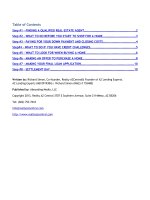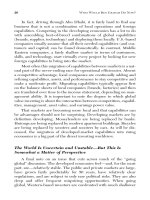Jossey bass performance based management what every manager should do to get results ebook lib
Bạn đang xem bản rút gọn của tài liệu. Xem và tải ngay bản đầy đủ của tài liệu tại đây (1.88 MB, 236 trang )
www.GetPedia.com
* The Ebook starts from the next page : Enjoy !
About This Book
Why is this topic important?
Every day first line managers and supervisors struggle with deficiencies and inequities
in their organization, their leadership, and their people. The book recognizes that defi-
ciencies exist, yet focuses on those things that first line managers and supervisors can
do to be more effective.
What can you achieve with this book?
The book serves as a working guide. It is full of proven, practical guidelines, tools, and
tips to overcome deficiencies and inequities, whether they are in the organization, the
leadership, or the employees. The guidelines and tools on the accompanying CD can be
immediately put to use or modified to accommodate unique situations.
How is this book organized?
The book is organized around the four major roles of first line managers and supervi-
sors. There are two chapters dedicated to each role. The first role is to provide direction.
The chapters explain how managers and supervisors can provide direction whether or
not they have been given clear direction themselves. The second role is to communicate
expectations. The chapters explain how to identify behaviors that lead to results and
how to measure performance. The third role is to equip people with skills, information,
and tools so they can succeed. The chapters explain how to orient new people to the
job, how to help them get the most from training, and how to make use of quick refer-
ence guides so people avoid mistakes and perform more consistently. The fourth role is
about how to steer or keep people on course through feedback and incentives. The
chapters explain how to take the pain out of giving people feedback and how to rec-
ognize and reward behaviors that produce results.
hale_fm.qxd 8/26/03 11:30 AM Page i
About Pfeiffer
Pfeiffer serves the professional development and hands-on resource needs of
training and human resource practitioners and gives them products to do their
jobs better. We deliver proven ideas and solutions from experts in HR devel-
opment and HR management, and we offer effective and customizable tools
to improve workplace performance. From novice to seasoned professional,
Pfeiffer is the source you can trust to make yourself and your organization
more successful.
Essential Knowledge Pfeiffer produces insightful, practical, and
comprehensive materials on topics that matter the most to training
and HR professionals. Our Essential Knowledge resources translate the expertise
of seasoned professionals into practical, how-to guidance on critical workplace
issues and problems. These resources are supported by case studies, worksheets,
and job aids and are frequently supplemented with CD-ROMs, websites, and
other means of making the content easier to read, understand, and use.
Essential Tools Pfeiffer’s Essential Tools resources save time and
expense by offering proven, ready-to-use materials—including exercises,
activities, games, instruments, and assessments—for use during a training
or team-learning event. These resources are frequently offered in loose-leaf or
CD-ROM format to facilitate copying and customization of the material.
Pfeiffer also recognizes the remarkable power of new technologies in
expanding the reach and effectiveness of training. While e-hype has often
created whizbang solutions in search of a problem, we are dedicated to
bringing convenience and enhancements to proven training solutions. All our
e-tools comply with rigorous functionality standards. The most appropriate
technology wrapped around essential content yields the perfect solution for
today’s on-the-go trainers and human resource professionals.
Essential resources for training and HR professionals
www.pfeiffer.com
hale_fm.qxd 8/26/03 11:30 AM Page ii
◆
Performance-Based
Management
What Every Manager
Should Do to
Get Results
Judith Hale
www.pfeiffer.com
hale_fm.qxd 8/26/03 11:30 AM Page iii
Copyright © 2004 by John Wiley & Sons, Inc.
Published by Pfeiffer
An Imprint of Wiley.
989 Market Street, San Francisco, CA 94103-1741 www.pfeiffer.com
Except as specifically noted below, no part of this publication may be reproduced, stored in a retrieval
system, or transmitted in any form or by any means, electronic, mechanical, photocopying, recording,
scanning, or otherwise, except as permitted under Section 107 or 108 of the 1976 United States
Copyright Act, without either the prior written permission of the Publisher, or authorization through
payment of the appropriate per-copy fee to the Copyright Clearance Center, Inc., 222 Rosewood
Drive, Danvers, MA 01923, 978-750-8400, fax 978-750-4470, or on the web at www.copyright.com.
Requests to the Publisher for permission should be addressed to the Permissions Department, John
Wiley & Sons, Inc., 111 River Street, Hoboken, NJ 07030, 201-748-6011, fax 201-748-6008,
e-mail:
Certain pages from this book and all the materials on the accompanying CD-ROM are designed for
use in a group setting and may be customized and reproduced for educational/training purposes. The
reproducible pages are designated by the appearance of the following copyright notice at the foot of
each page:
Performance-Based Management. Copyright © 2004 by John Wiley & Sons, Inc. Reproduced by
permission of Pfeiffer, an Imprint of Wiley. www.pfeiffer.com
This notice may not be changed or deleted and it must appear on all reproductions as printed.
This free permission is restricted to limited customization of the CD-ROM materials for your
organization and the paper reproduction of the materials for educational/training events. It does not
allow for systematic or large-scale reproduction, distribution (more than 100 copies per page, per
year), transmission, electronic reproduction or inclusion in any publications offered for sale or used for
commercial purposes—none of which may be done without prior written permission of the Publisher.
For additional copies/bulk purchases of this book in the U.S. please contact 800-274-4434.
Pfeiffer books and products are available through most bookstores. To contact Pfeiffer directly call our
Customer Care Department within the U.S. at 800-274-4434, outside the U.S. at 317-572-3985 or fax
317-572-4002 or visit www.pfeiffer.com.
Pfeiffer also publishes its books in a variety of electronic formats. Some content that appears in print
may not be available in electronic books.
Printed in the United States of America
ISBN: 0-7879-6036-5
Library of Congress Cataloging-in-Publication Data
Hale, Judith A.
Performance-based management : what every manager should
do to get results/Judith Hale.
p. cm.
Includes bibliographical references and index.
ISBN 0-7879-6036-5 (alk. paper)
1. Management by objectives. 2. Performance. 3. Supervision of
employees. I. Title.
HD30.65.H355 2004
658.4'012—dc21 2003008893
Acquiring Editor: Matthew Davis
Director of Development: Kathleen Dolan Davies
Editor: Rebecca Taff
Senior Production Editor: Dawn Kilgore
Manufacturing Supervisor: Bill Matherly
Interior Design: Joseph Piliero
Cover Design: Laurie Anderson
Illustrations: Lynn Kearny and Richard Sheppard
Printed in the United States of America
Printing 10987654321
hale_fm.qxd 8/26/03 11:30 AM Page iv
Chapter 1
Chapter 2
◆
Contents
List of Figures / ix
CD-ROM Contents / xi
Preface / xiii
Introduction / 1
How Leaders Set the Direction / 9
Performance Improvement / 10
Common Missteps / 10
Leadership / 11
Goals, Objectives, and Outcomes / 13
Messages and Direction / 21
Consistency / 21
Off the Cuff / 24
Tips / 30
Summary / 31
Where to Learn More / 32
Notes / 32
How to Provide Direction / 35
Performance Improvement / 35
Common Missteps / 36
Governance / 37
Endorsement and Legitimacy / 42
Operational Protocols / 43
Tools and Techniques / 44
Tips / 54
v
hale_fm.qxd 8/26/03 11:30 AM Page v
Summary / 54
Where to Learn More / 54
Notes / 55
How to Set Expectations / 57
Performance Improvement / 58
Common Missteps / 58
What Sets Expectations / 59
Where to Find Measures / 63
What to Measure / 65
Jobs and Measures / 67
What to Use for Comparison / 74
Tips / 74
Summary / 75
Where to Learn More / 75
Note / 75
How to Identify Behaviors That Lead to Performance / 77
Performance Improvement / 77
Common Missteps / 78
Competencies and Competency Statements / 78
Using Competencies to Select People / 83
Tips / 86
Summary / 86
Where to Learn More / 87
Note / 87
How to Use Orientations and Training Effectively / 117
Performance Improvement / 117
Common Missteps / 117
Orientation / 118
Readiness Check / 119
Training / 122
Tips / 130
Summary / 130
Where to Learn More / 130
How to Use Job Aids to Support Performance / 133
Performance Improvement / 133
Common Missteps / 134
Job Aids or Quick Reference Guides / 134
Standards, Work Rules, and Procedures / 145
vi ◆ Contents
Chapter 4
Chapter 5
Chapter 6
Chapter 3
hale_fm.qxd 8/26/03 11:30 AM Page vi
Tips / 152
Summary / 152
Where to Learn More / 152
Notes / 152
How to Make Giving Feedback Less Painful / 155
Performance Improvement / 155
Common Missteps / 156
Performance Problems / 156
Feedback and Coaching / 157
Why We Give Feedback / 158
Why Giving Feedback Is Difficult / 159
System Solutions / 159
Human Connection / 169
Performance Appraisals and Feedback / 170
Tips / 175
Summary / 176
Where to Learn More / 176
Note / 177
How to Recognize and Reward People / 179
Performance Improvement / 180
Common Missteps / 181
Leading and Lagging Indicators / 181
Leading Indicators / 183
Lagging Indicators / 187
Recognizing the Unseen and the Unclean / 188
Peer Recognition / 190
Compensation / 192
Meaningful Work / 193
Aligning Incentives / 193
Tips / 197
Summary / 198
Where to Learn More / 199
Notes / 199
Index / 201
About the Author / 217
How to Use the CD-ROM / 219
Pfeiffer Publications Guide / 223
◆ Contents vii
Chapter 8
Chapter 7
hale_fm.qxd 8/26/03 11:30 AM Page vii
hale_fm.qxd 8/26/03 11:30 AM Page viii
◆
List of Figures
Figure I.1 Leadership Roles for Performance / 5
Figure 1.1 Leadership Roles / 8
Figure 1.2 Ripple Effect of Goals and Objectives / 12
Figure 1.3 Hierarchy of Goals and Objectives / 13
Figure 2.1 Leadership Roles / 34
Figure 2.2 Governance Structure / 41
Figure 2.3 Sample Cross-Functional Chart / 46
Figure 2.4 Cross-Functional Chart / 51
Figure 2.5 Sample RASCI Chart / 53
Figure 3.1 Leadership Roles / 56
Figure 3.2 Three Ways to Measure Job Performance / 68
Figure 3.3 Measures Worksheet / 72
Figure 3.4 Means and Evidence / 73
Figure 4.1 Leadership Roles / 76
Figure 4.2 Comparison of Leader Behaviors / 79
Figure 4.3 Behaviors Across Roles / 80
Figure 4.4 Performance Checklist Template / 82
Figure 4.5 Sample Form to Interview for Project
Management Skills / 85
Figure 5.1 Leadership Roles / 116
Figure 6.1 Leadership Roles / 132
Figure 6.2 Sample Worksheet: How to Balance
Your Checkbook / 136
Figure 6.3 Sample Array: Candy Box Lid / 137
ix
hale_fm.qxd 8/26/03 11:30 AM Page ix
Figure 6.4 Sample If, Then Decision Table: How to Clean
Exterior Surfaces / 137
Figure 6.5 Sample Flow Chart: Starting a Task / 138
Figure 6.6 Sample Checklist: Air Sampler Maintenance
Checklist / 139
Figure 6.7 Dirty Oil / 144
Figure 6.8 Pitch Card / 145
Figure 7.1 Leadership Roles / 154
Figure 7.2 Meeting Management Checklist / 164
Figure 7.3 Phenomena That Contribute to Unfair Evaluations / 172
Figure 7.4 Sample Rating Scale / 172
Figure 8.1 Leadership Roles / 178
Figure 8.2 A Comparison of Incentives and Rewards / 180
Figure 8.3 Identifying Leading Indicators / 187
Figure 8.4 Matrix to Align Incentives / 197
x ◆ List of Figures
hale_fm.qxd 8/26/03 11:30 AM Page x
◆
CD-ROM Contents
Tool 1.1 How to Identify Goals and Objectives / 16
Tool 1.2 How to Identify What Is Important / 23
Tool 1.3 How to Challenge Mixed Messages / 25
Tool 2.1 How to Design a Governance Structure / 39
Tool 2.2 How to Develop and Use Cross-Functional Charts / 45
Tool 2.3 How to Develop Governing Principles, Protocols, and
Ground Rules / 47
Tool 2.4 How to Develop Operating Guidelines and
Procedures / 48
Tool 2.5 How to Develop and Use RASCI Charts / 50
Tool 3.1 How to Identify Deliverables / 61
Tool 3.2 How to Evaluate Your Current Use of Measures / 66
Tool 3.3 How to Select Measures / 72
Tool 4.1 How to Identify Desired Behaviors / 81
Tool 4.2 How to Develop Behavioral Interview Questions / 83
Tool 4.3 Job Aid for Describing Behaviors by Job Level and
Level of Performance / 88
Tool 4.3a Job Aid for Describing Behaviors by Job Level and
Level of Performance—Senior Manager / 90
Tool 4.3b Job Aid for Describing Behaviors by Job Level and
Level of Performance—Mid-Level Manager / 95
Tool 4.3c Job Aid for Describing Behaviors by Job Level and
Level of Performance—First-Level Manager / 100
xi
hale_fm.qxd 8/26/03 11:30 AM Page xi
Tool 4.3d Job Aid for Describing Behaviors by Job Level and
Level of Performance—Supervisor / 104
Tool 4.3e Job Aid for Describing Behaviors by Job Level and Level
of Performance—Individual Contributor / 111
Tool 5.1 How to Orient New Employees / 120
Tool 5.2 How to Get the Most from Training / 124
Tool 5.3 How to Make On-the-Job Training More Effective / 128
Tool 6.1 How to Select and Use Job Aids / 140
Tool 6.2 How to Identify and Use Standards, Work Rules,
and Procedures / 147
Tool 7.1 How to Use Project Plans and Action Plans for Giving
Feedback / 161
Tool 7.2 How to Use Meeting Guidelines to Give Feedback / 164
Tool 7.3 How to Obtain and Use Internal Customer
Feedback / 167
Tool 7.4 Guidelines for Giving Feedback / 173
Tool 8.1 How to Identify Leading Indicators / 186
Tool 8.2 How to Identify and Select Incentives / 191
Tool 8.3 How to Align Recognition and Rewards / 196
xii ◆ CD-ROM Contents
hale_fm.qxd 8/26/03 11:30 AM Page xii
◆
Preface
This book is based on more than twenty-five years of experience witnessing
managers and supervisors succeed despite inept leadership, ill-formed human
resource policies, and inadequate information and communication systems.
They succeeded because of their respect for others, their ingenuity in ad-
dressing problems, and mostly because of their unwavering optimism. I have
immense respect for the people who live day-to-day with dysfunctional man-
agement systems. Geary Rummler said, “Put a good person in a bad system,
and the system will win every time.”
1
This may be true in many circumstances,
but I see people succeeding in bad systems. This book is meant to help man-
agers and supervisors become even more effective, whether they work in good
or bad systems.
The primary audience for this book is managers and supervisors who are
responsible for:
• The performance of employees, contractors, suppliers, and third-party
after-market partners
• Facilitating the successful deployment and adoption of major initiatives
• Evaluating recommended solutions to improving performance
• Working with others not in their chain of command
A secondary audience is internal and external consultants (human resource
development, training and development).
AUDIENCE FOR
THE BOOK
xiii
hale_fm.qxd 8/26/03 11:30 AM Page xiii
The tips, guidelines, and tools are designed to be workable and practical so
managers and supervisors can more effectively improve human performance.
Some very special people played a major role in helping make this book pos-
sible. They painstakingly read the first draft of every chapter and added
insights, examples, and guidance. They are Deb Barrett, Training Manager;
Ann Berasley, MBA; Mike Brogan, Manager of Organizational Development,
Metropolitan Washington Airports Authority; Ann Daniels, Chipote Restau-
rants; Cordell Hauglie, Consultant, Delivery Systems Consulting & Training,
Boeing; David R. Haskett, Manager, Instructional Design, Johnson Controls,
Inc.; Jim Heine, Manager of Utility Services, Argonne National Laboratory;
Nora Holcomb, Manager of Internal and External Training, CCC Information
Systems; Roger Kaufman, Professor, Florida State University; Donald
L. Kirkey, Learning & Development Manager—Global Operations, Johnson
Controls, Inc.; Karen G. Kroczek, Manager of Technical Training, Plant
Facilities and Services Division, Argonne National Laboratory; Dean R.
Larson, Ph.D., CSP CEM CPEA, Department Manager, Safety & Industrial
Hygiene, U.S. Steel—Gary Works; Annemarie Laures, Director, Learning
Services, Walgreen Co.; Jim Momsen, Contractor, Instructional Designer;
Gwendolyn Nichols-White, Implementation Manager, U.S. Cellular; Tom
Norfleet, Manager of Corporate Services, Michigan Auto; Karen Preston,
Director, Systems Support & Process Improvement Services, Performance
Development Department, Walgreen Co.; George Pollard, Assistant Professor
of Education and Director of Advance Programs, Crichton College; Joeli
Ridley, Manager of Certification, Charles Schwab; Malou Roth, Consultant;
Belinda Silber, Owner, Divanoir Catering; Kenneth Silber, Ph.D., Associate
Professor, Educational Technology, Research and Assessment, Northern Illi-
nois University; Mike Singleton, Holnam Industries; Charline Wells, Manager
of Training and Performance, Sandia National Laboratory.
I was fortunate to have the continued confidence of Kathleen Dolan
Davies and Matt Davis of Pfeiffer, whose support made this book possible.
Special thanks goes to my friend Sue Simons, who continues to encourage me
to be true to my style of simplicity and directness.
1. This quote is from Training magazine (December 1986, p. 43.)
xiv ◆ Preface
ACKNOWLEDG-
MENTS
NOTE
hale_fm.qxd 8/26/03 11:30 AM Page xiv
◆
Introduction
This book has stories, examples, and guidelines to help managers and
supervisors improve the performance of their work units. Performance im-
provement operates on the premise that to be effective, individuals and groups
require:
Direction About What the Organization Wants to Accomplish
• Consistent direction from the leadership
• Management processes that allow for efficient decision making
Clear Expectations
• A clear understanding of what is expected of them
• An explanation of the criteria that will be used to judge the adequacy of
their work
The Equipment to Do the Job
• Training and the information required for the job
• Performance support tools to help them remember how to do the job right
and efficiently
Information and Incentives to Keep Them on Track
• Feedback on how well they are doing and coaching on how to improve
• Rewards and incentives that support the behaviors that produce the results
Each of these requirements is discussed in greater detail in subsequent
chapters.
1
hale14326_intro.qxd 8/26/03 11:31 AM Page 1
The functions of management are generally accepted as plan, staff, organize,
and control along with lead, communicate, and motivate. The functions can
be thought of as managerial duties and organizational processes. However you
think of them, the functions, collectively, describe what has to happen for an
organization to be competitive and to fulfill its mandate. These functions are
based on a fundamental set of beliefs:
• Goals should be set
• Tasks can and must be planned, organized, and staffed
• Controls can and must be in place to assure that tasks are executed as
expected
• Managers and supervisors can and must provide leadership, communicate
the goals and plans, and motivate people to execute their tasks
However, the functions of management alone are not sufficient for people
and organization to perform. To “perform” means to deliver something of
worth with integrity. What you deliver is of worth if it contributes to society,
the community, the organization, the customers, and the employees. Integrity
is doing it without sacrificing environmental, social, or financial assets or rela-
tionships in the long run. Therefore, performance is about the ability to de-
liver on a promise while having the resiliency to withstand challenges, with few,
if any, negative aftereffects. It applies to organizations, people, individually and
collectively, systems, processes, products, and services.
Performance improvement is not a substitute for the functions of planning,
organizing, controlling, leading, staffing, and so on. However, it imposes a per-
spective that questions the worth and worthiness of the effort, the results
achieved, and the methods used. Planning, for example, is a process for setting
goals or objectives; and plans are made up of strategies and tactics to accom-
plish the goal. Performance improvement questions the worthiness of the goal
and the efficacy of the plan.
1,2
Performance is about doing meaningful work in effective and efficient
ways. Planning, organizing, controlling, leading, communicating, and moti-
vating will help you do it. However, the management functions, in and of
themselves, are not a substitute for maintaining focus, being grounded in the
real constraints facing the organization, collaborating with people who have
the resources, talent, and willingness to contribute to accomplishing the goal,
2 ◆ Performance-Based Management
FUNCTIONS OF
MANAGEMENT
PERFORMANCE
IMPROVEMENT
hale14326_intro.qxd 8/26/03 11:31 AM Page 2
and adding value to the overall effort. Just as the management functions
presume work has to be organized with checks and balances in place, perfor-
mance improvement presumes it is management’s responsibility to do the
following:
• Assure that where the organization is headed, what it does, and how it does
it are appropriate considering the impact on society, the community,
investors, customers, employees, and the competition
• Provide people with the direction, information, tools, materials, equip-
ment, and appropriate rewards required for their efforts to produce the
desired results
Performance improvement is a result-driven perspective to work, the
workplace, and the worker. Recognizing the importance of organizing tasks
and responsibilities, performance asks, “What are we about? What do we want
to accomplish? What do people require to accomplish it? What are the best
methods for providing what they require? What is the best way to motivate
people so their efforts are more likely to produce the results we want?” And
“What do we expect people to bring or contribute to the effort?” The princi-
ples of performance improvement advocate a collaborative and systematic
approach to answering these questions.
Performance improvement is about what you do, why you do it, and how
you go about it. A group performs when it achieves results in ways that are
socially, environmentally, and economically prudent. Organizations, divisions,
departments, work groups, teams, and individuals generate things that are used
by someone else. If those things are not deemed valuable or have too high a
social or economic cost, the people, individually and collectively, did not per-
form. When we say someone or something performs, we mean it delivers as
promised.
Organizations perform when they produce goods and services that are
valued by consumers and reap benefits to stockholders, but not at the expense
of the environment, community, or employees. Systems perform when they
support the information, communication, and transformation requirements of
production and decision making, but not at the expense of other systems or
departments. Processes perform when they generate products to a standard
with minimal waste of time, money, materials, or human effort, but not if they
operate as stand-alone silos that limit the effectiveness of other groups or
processes. People perform when their efforts result in outputs that lead to
positive short-term and long-term consequences.
◆ Introduction 3
hale14326_intro.qxd 8/26/03 11:31 AM Page 3
Performance improvement, like management, operates from a fundamental
set of beliefs or principles that include:
• Focus on results, keep the end state in mind, and do not become distracted
• Look at situations systemically, consider the larger picture, and identify
ways to work effectively within constraints and competing objectives
• Add value to your people, your customers, and the organization now and
in the future, because well-being and loyalty are critical to sustainable
success
• Partner and collaborate with the appropriate groups and individuals, as
success requires the expertise, understanding, and support of many people
• Be disciplined in how you approach and execute the work to be done; at
minimum assess and analyze the facts, challenge assumptions, test out
ideas, weigh alternatives, measure work in progress, and evaluate the results
Therefore, performance improvement is about staying focused on the
right goals while dealing with real constraints and competing pressures, doing
that which adds value, and collaborating with the right people. It is about
being systematic and disciplined when you assess the situation, analyze
probable causes, design and implement workable solutions, and evaluate
whether what you did made a difference. Being proficient in both manage-
ment and performance improvement is essential for personal and organiza-
tional effectiveness.
The book has eight chapters that are organized around four main roles of the
first line manager and supervisors (see Figure I.1).
Each chapter contains examples, guidelines, tools, tips, common missteps,
and suggestions on where to learn more for each role. A CD-ROM disk con-
taining all of the job aids and templates is found at the end of the book.
Role One: Provide Direction
Chapter 1: How Leaders Set the Direction.
The goal of this chapter is to pre-
sent ideas on how first-line managers and supervisors can stay help others stay
focused on what matters. There are three tools in this chapter:
• Tool 1.1: How to Identify Goals and Objectives
• Tool 1.2: How to Identify What Is Important
• Tool 1.3: How to Challenge Mixed Messages
4 ◆ Performance-Based Management
PRINCIPLES OF
PERFORMANCE
IMPROVEMENT
HOW THE BOOK
IS ORGANIZED
hale14326_intro.qxd 8/26/03 11:31 AM Page 4
Chapter 2: How to Provide Direction. The goal of this chapter is to help man-
agers and supervisors understand ways to provide direction despite any
limitations in leadership. There are five tools in this chapter:
• Tool 2.1: How to Design a Governance Structure
• Tool 2.2: How to Develop and Use Cross-Functional Charts
• Tool 2.3: How to Develop Governing Principles, Protocols, and Ground
Rules
• Tool 2.4: How to Develop Operating Guidelines and Procedures
• Tool 2.5: How to Develop and Use RASCI Charts
◆ Introduction 5
Figure I.1. Leadership
Roles for Performance
Lynn Kearny, CPT, Graphic Recorder
hale14326_intro.qxd 8/26/03 11:31 AM Page 5
Role Two: Set Expectations
Chapter 3: How to Set Expectations.
The goal of this chapter is to present
ideas on how to identify and communicate expectations to employees. It in-
cludes defining deliverables, customers, and performance measures. There are
three tools in this chapter:
• Tool 3.1: How to Identify Deliverables
• Tool 3.2: How to Evaluate Your Current Use of Measures
• Tool 3.3: How to Select Measures
Chapter 4: How to Identify Behaviors That Lead to Performance. The goal
of this chapter is to present ideas on how to identify the behaviors that lead to
performance and use them to communicate expectations. There are three
tools in this chapter:
• Tool 4.1: How to Identify Desired Behaviors
• Tool 4.2: How to Develop Behavioral Interview Questions
• Tool 4.3: Job Aid for Describing Behaviors by Job Level and Level of
Performance
Part A—Senior Manager
Part B—Mid-Level Manager
Part C—First-Level Manager
Part D—Supervisor
Part E—Individual Contributor
Role Three: Equip People to Perform
Chapter 5: How to Use Orientations and Training Effectively.
The goal of
this chapter is to explain how to prepare people to do their jobs. It includes
descriptions on how to orient and train people effectively. There are three tools
in this chapter:
• Tool 5.1: How to Orient New Employees
• Tool 5.2: How to Get the Most from Training
• Tool 5.3: How to Make On-the-Job Training More Effective
Chapter 6: How to Use Job Aids to Support Performance. The goal of this
chapter is to explain how to better equip people to do their jobs. It includes
the appropriate use of job aids, standards, work rules, and procedures. There
6 ◆ Performance-Based Management
hale14326_intro.qxd 8/26/03 11:31 AM Page 6
are two tools in this chapter:
• 6.1: How to Select and Use Job Aids
• 6.2: How to Identify and Use Standards, Work Rules, and Procedures
Role Four: Steer so People Stay on Course
Chapter 7: How to Make Giving Feedback Less Painful.
The goal of this
chapter is to present ideas on how to give people feedback in ways that are
meaningful to them and less painful for the manager or supervisor. There
are four tools in this chapter:
• Tool 7.1: How to Use Project Plans and Action Plans for Giving Feedback
• Tool 7.2: How to Use Meeting Guidelines to Give Feedback
• Tool 7.3: How to Obtain and Use Internal Customer Feedback
• Tool 7.4: Guidelines for Giving Feedback
Chapter 8: How to Recognize and Reward People. The goal of this chapter
is to present ideas on how to shape people’s performance through the use of
incentives. There are three tools in this chapter:
• Tool 8.1: How to Identify Leading Indicators
• Tool 8.2: How to Identify and Select Incentives
• Tool 8.3: How to Align Recognition and Rewards
1. The requirements for performance have been identified and validated by many
people. One of those was Tom Gilbert, who presented his “Probe Model” as a
framework for diagnosing why people do not perform as expected. His ideas
were further developed in Human Competence (San Francisco, CA: Jossey-Bass,
1978).
2. Roger Kaufman suggests there are three levels of clients and beneficiaries of what
any organization uses, does, produces, and delivers. He calls the primary client as
society and community that he terms as Mega planning. When the primary client
and beneficiary of what is used and done is the organization itself, it is termed
macro planning, and when the target is individuals and small groups, that is “micro
planning.” Kaufman suggests that strategic thinking and planning is characterized
by starting at the mega—societal level. Two of Kaufman’s books that discuss the
concept of worth are Strategic Thinking: A Guide to Identifying and Solving Prob-
lems (rev. ed.) (Arlington, VA/Washington, DC: American Society for Training &
Development and the International Society for Performance Improvement, 1998)
and Mega Planning: Practical Tools for Organizational Success. (Thousand Oaks,
CA: Sage Publications, 2000).
◆ Introduction 7
NOTES
hale14326_intro.qxd 8/26/03 11:31 AM Page 7
Figure 1.1. Leadership Roles
Lynn Kearny, CPT, Graphic Recorder
hale14326_ch01.qxd 8/26/03 11:31 AM Page 8
◆
Chapter 1
How Leaders Set
the Direction
What are we trying to do?
Where are we headed?
This chapter explains the role of leadership at all levels in the organization
in providing direction. Leadership is like a beacon or navigational aid. People
must know what the goal or destination is and they require signals over the
course of their efforts to confirm that they are on track. No ship’s captain would
set sail without knowing the destination and having the ability to know whether
or not he was on course. No airplane pilot would take off without knowing the
destination and having the capability to validate whether or not the plane was
on its prescribed flight path. Yet organizations repeatedly engage in activities
and launch new initiatives, products, and technology without understanding
or being in agreement on the goal or having the ability to stay on course.
People require three types of information to do their jobs effectively. The
first type should come from top leadership, as it is about where the organization
is headed, what the priorities are, and what the organization is doing in terms of
investment to compete in the marketplace or fulfill its mission. The second type
should come from human resources (HR) and the manager or supervisor, as it
is about what is expected of individuals in terms of their roles, goals, and per-
formance criteria. The third type comes from the training department and the
manager or supervisor, as it is about what to do, how to do it, and why. Managers
and supervisors have an important role in assuring that people receive all three
types of information. This chapter focuses on how to use the information that
comes from top management to make sure goals, objectives, deliverables,
activities, and measures are aligned and understood by the people.
•A goal is an end state or condition toward which human effort is directed
•Anobjective is an interim or enabling state or condition that, when
combined with other objectives, leads to a goal
9
hale14326_ch01.qxd 8/26/03 11:31 AM Page 9









